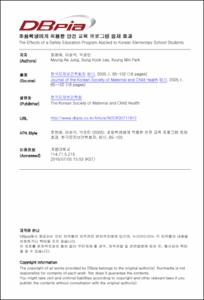초등학생에게 적용한 안전 교육 프로그램 중재 효과
- Keimyung Author(s)
- Park, Kyung Min
- Department
- Dept. of Nursing (간호학)
- Journal Title
- 한국모자보건학회지
- Issued Date
- 2005
- Volume
- 9
- Issue
- 1
- Keyword
- education safety; school health; children
- Abstract
- Objectives : This study was performed to evaluate the effects of a safety education program on Korean elementary school students.
Methods : The participants of this study included 126 third graders and mothers of O elementary school located in Pohang city. The participants were divided into two groups. Sixty-three students and the students’mothers were assigned to the education group and the other sixty-three counterparts were allocated to the non education group. The safety education program has been provided for the education group for 10 weeks. The questionnaires about safety knowledge, attitude, and practice behavior were distributed three times: pre test, post test(just three days after the education), and 2nd-post test(8 weeks of the education). For children in the education group, safety educations were provided three or four times a week for 10 weeks. Behavior check lists and diaries were included in the safety education. For the mothers of children in education group, the safety education was done for 10 weeks through educational letters and questionnaires. The effect of the education was evaluated with-test, t-test, ANCOVA, and multiple regression with SPSS 10.0/pc.
Results : After the safety education program application, the results of both the post test and the pre-2nd post test showed that safety knowledge(p<0.001, p<0.001) and behavior(p<0.001, p<0.001) scores of the children in the education group were significantly higher than those of the children in the noneducation group. However, attitude scores didn’t show significant difference between the two groups after 3 days’and 8 weeks’education. In mother cases, there was difference in the post test of safety knowledge(p=0.013) and safety attitude(p=0.043) between the education and noneducation group. However, knowledge and behavior were not significantly different between the pre-2nd post test. There was no difference between the two groups in practice behavior of both post and pre-2nd post test. As a result of multiple regression analysis, the associated factors with children safety behavior after 8 weeks’ education were the safety education program application of children, before education children safety behavior, the safety education program application of mother, mother’s thinking on necessity of school safety education.
Conclusions : This result showed that this safety education program changed safety behaviors of children. We expect that the result will contribute to the development of safety education programs for elementary students and mothers. It is necessary to make an further persistent effort to develop more effective children safety accident programs.
- Alternative Title
- The Effects of a Safety Education Program Applied to Korean Elementary School Students
- Keimyung Author(s)(Kor)
- 박경민
- Publisher
- College of Nursing
- Citation
- 정명애 et al. (2005). 초등학생에게 적용한 안전 교육 프로그램 중재 효과. 한국모자보건학회지, 9(1), 85–102.
- Type
- Article
- ISSN
- 1226-4652
- Appears in Collections:
- 2. College of Nursing (간호대학) > Dept. of Nursing (간호학)
- 파일 목록
-
-
Download
 oak-bbb-05144.pdf
기타 데이터 / 416.59 kB / Adobe PDF
oak-bbb-05144.pdf
기타 데이터 / 416.59 kB / Adobe PDF
-
Items in Repository are protected by copyright, with all rights reserved, unless otherwise indicated.